项目地址:https://github.com/qitianfeng/yiying-parent ,后续会将项目的具体功能以文档形式展示出来,各位可以点个star关注关注
在线电影系统是一个使用 B2C 的网站开发模式的在线视频观看及在线电影购票系统,主要分为前台用户平台和后台运营管理平台。实现电影的上传、解码、存储、点播
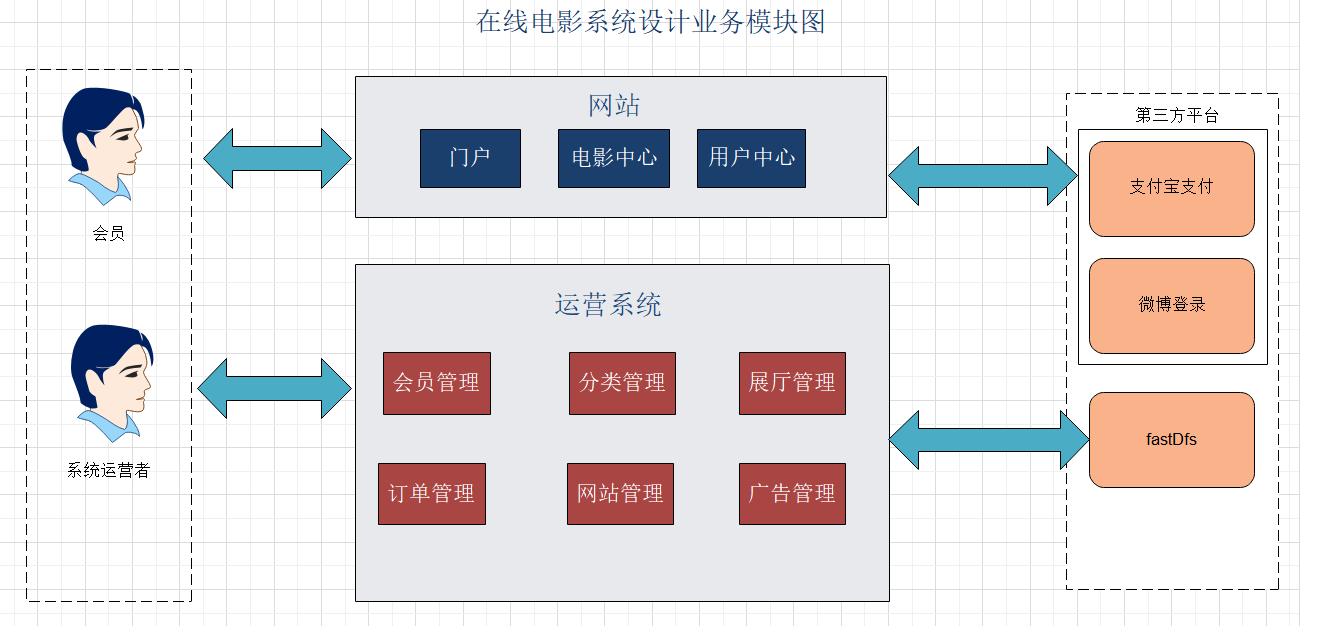
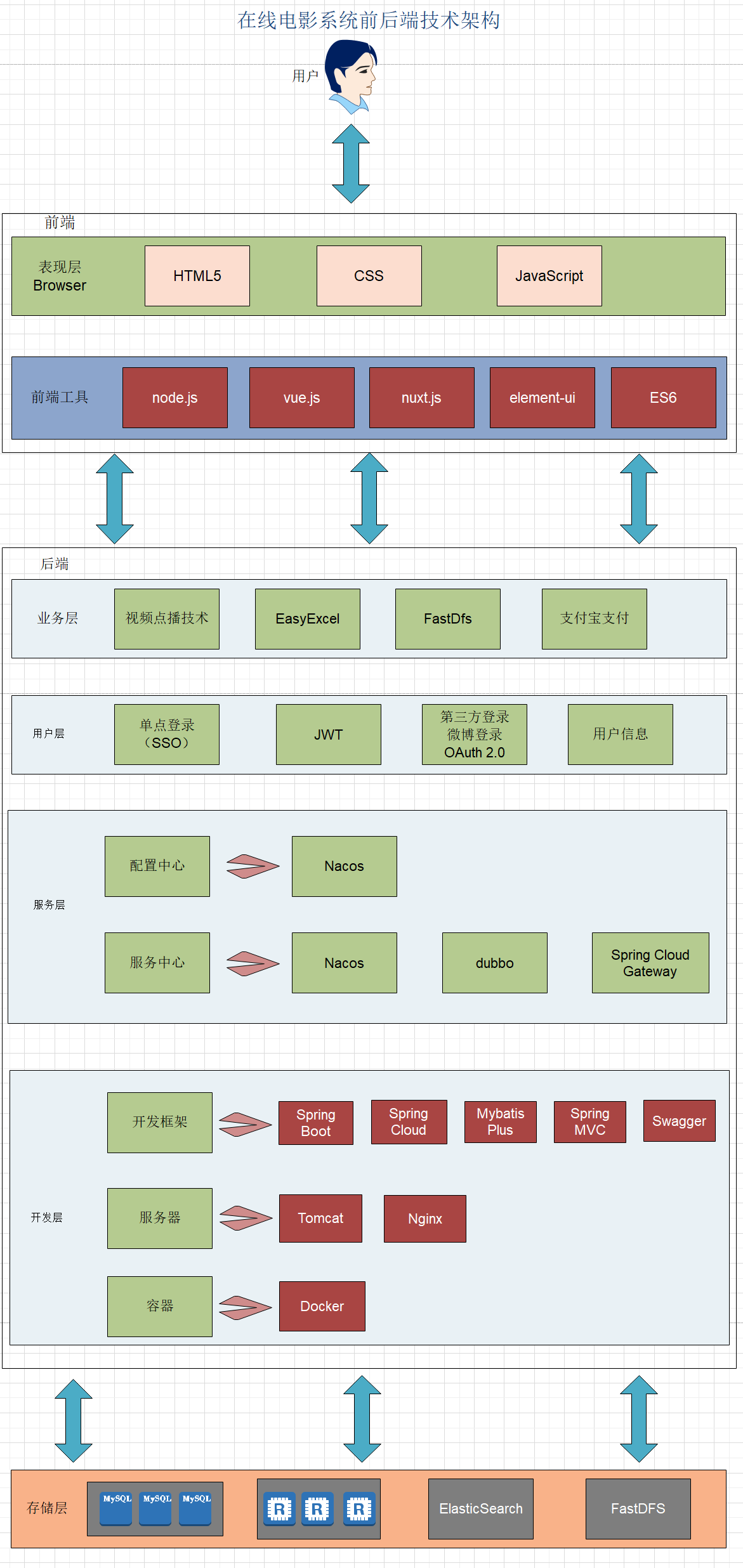
在线电影系统分为前台门户平台和后台管理平台,使用B2C模式,微服务技术架构,前后端分离开发。
前台的主要技术架构是:vue.js 、Nuxt.js 、Element-UI
后端的主要技术架构是:SpringBoot + SpringCloud + MyBatis-Plus + Dubbo + MySQL + Spring Cloud Getaway ;其他涉及到的中间件包括 Redis 、ElasticSearch 、令牌桶算法、FFMPEG 对视频的解码;业务中使用 EasyExcel 完成分类批量添加、JWT 用于前台门户的分布式单点登录;项目前后端分离开发,后端采用 Spring Cloud 微服务架构,持久层用的是 MyBatis-Plus,服务与服务之间使用 dubbo 进行 RPC 通信及使用 Swagger 技术生成各服务的接口文档。前端系统则分为前台用户系统和后台管理系统两部分。
前台系统包括:首页、电影中心、用户中心。
其中首页的主要分布为以下几个部分
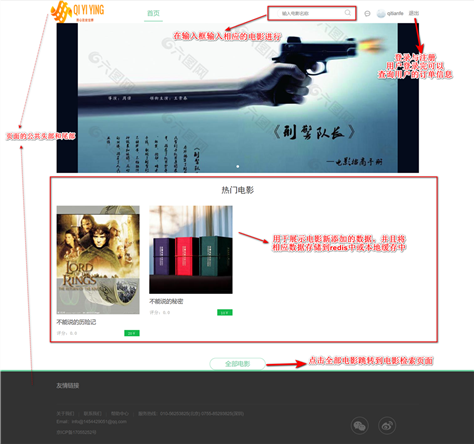
电影中心包括电影检索页面及电影的详细信息页面
其中电影的详情页面主要为用户展示电影的基本信息:
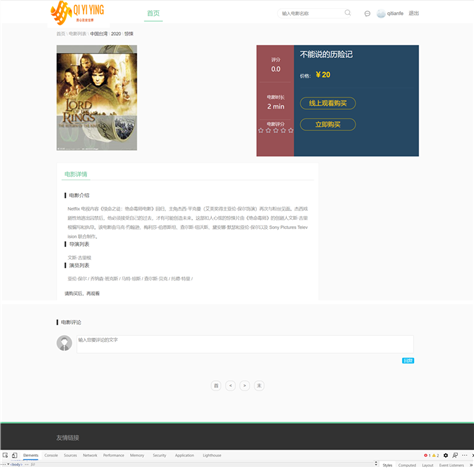
电影的搜索页面会将电影的分类信息进行展示,方便用户对感兴趣的分类信息进行检索查看,并且查询的关键字会进行高亮处理,给用户带来新的体验效果。
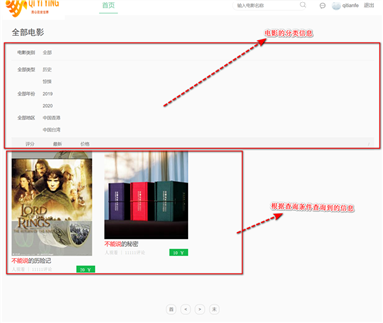
电影的下单页面分为两个页面
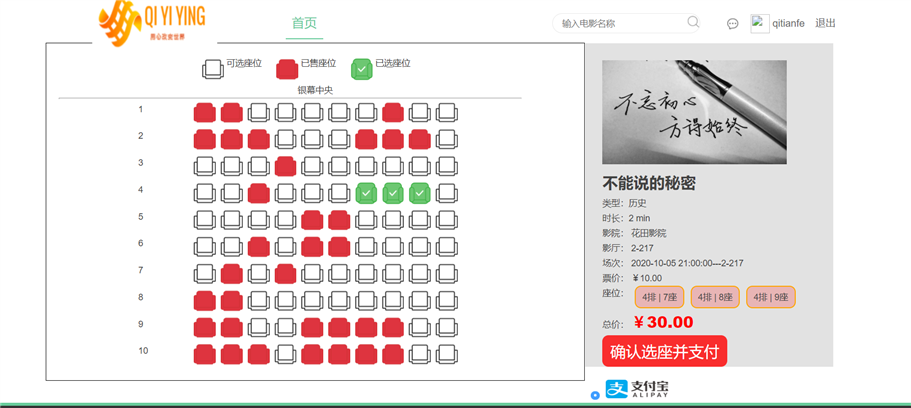
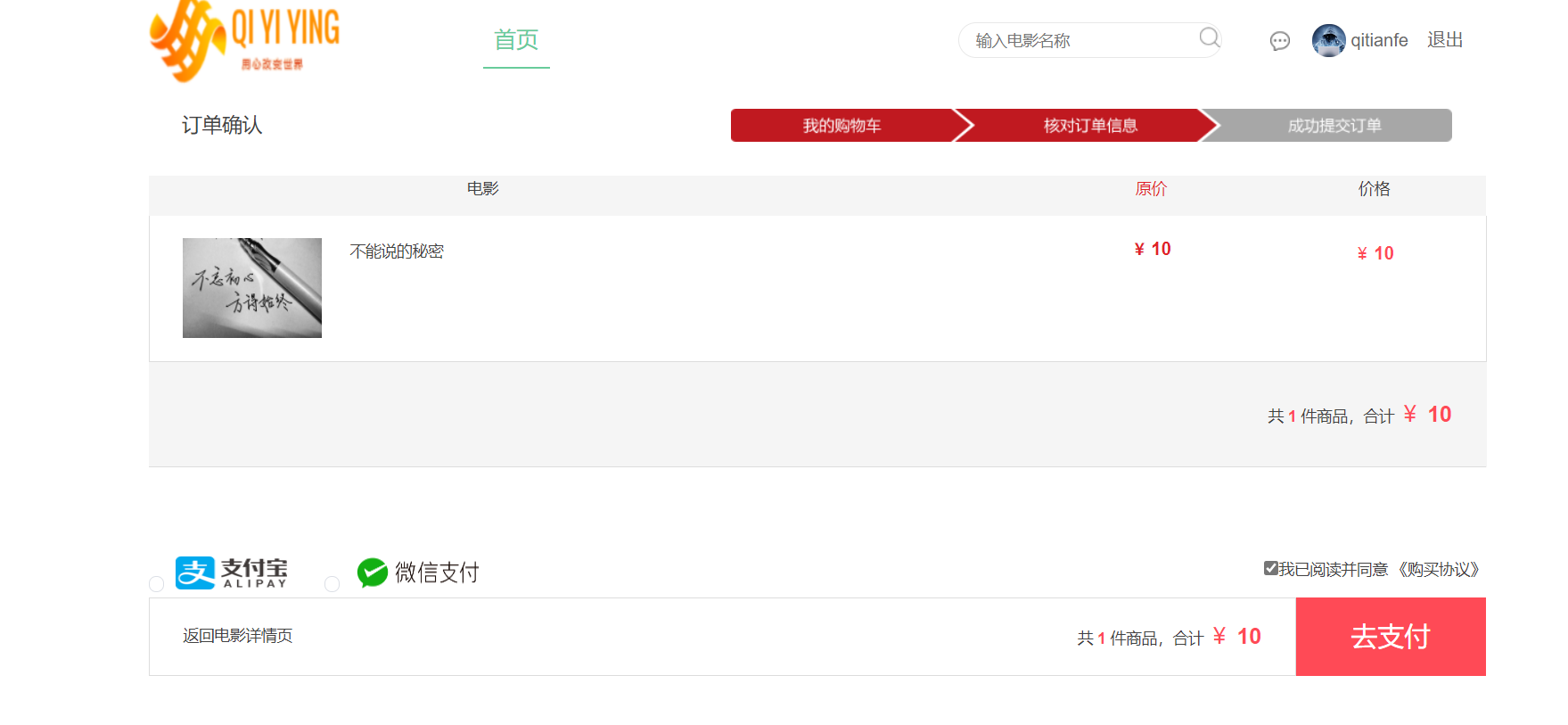
用户中心:注册与登录
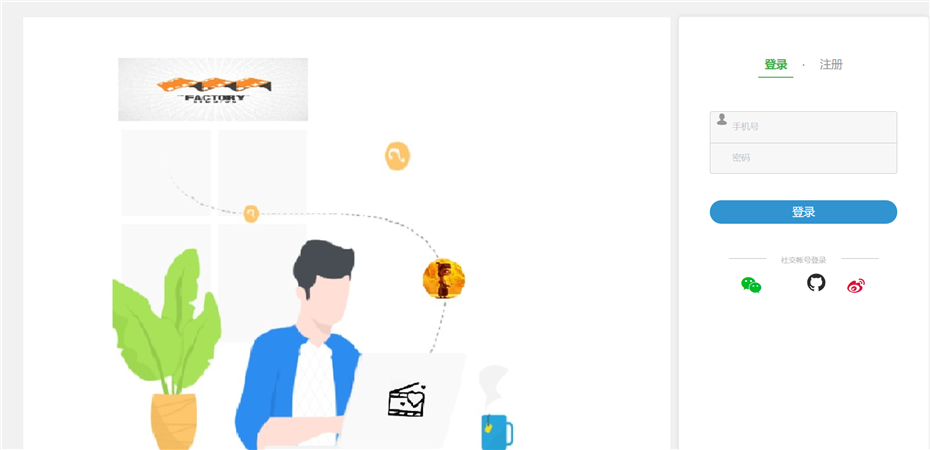
电影分类界面和电影展厅界面使用excel技术,将excel里的信息转化进而存储到数据库中
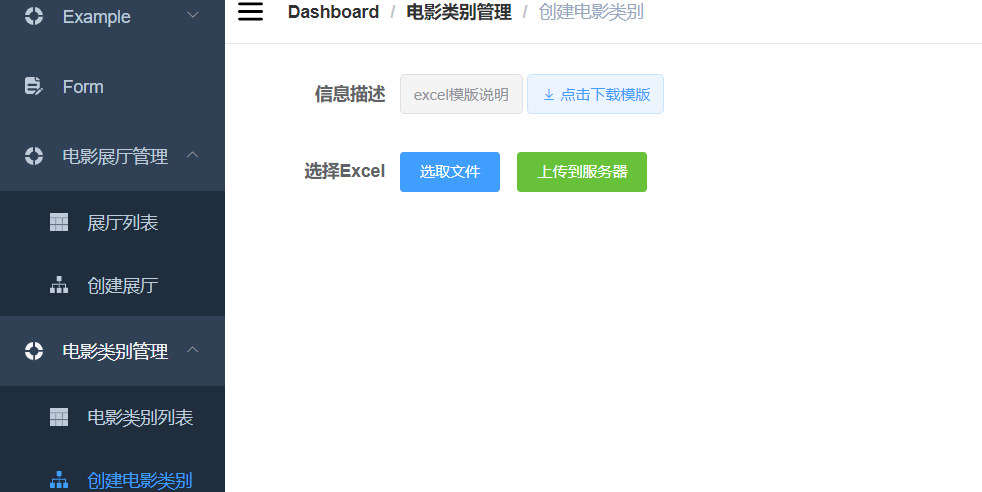
电影展厅展示界面
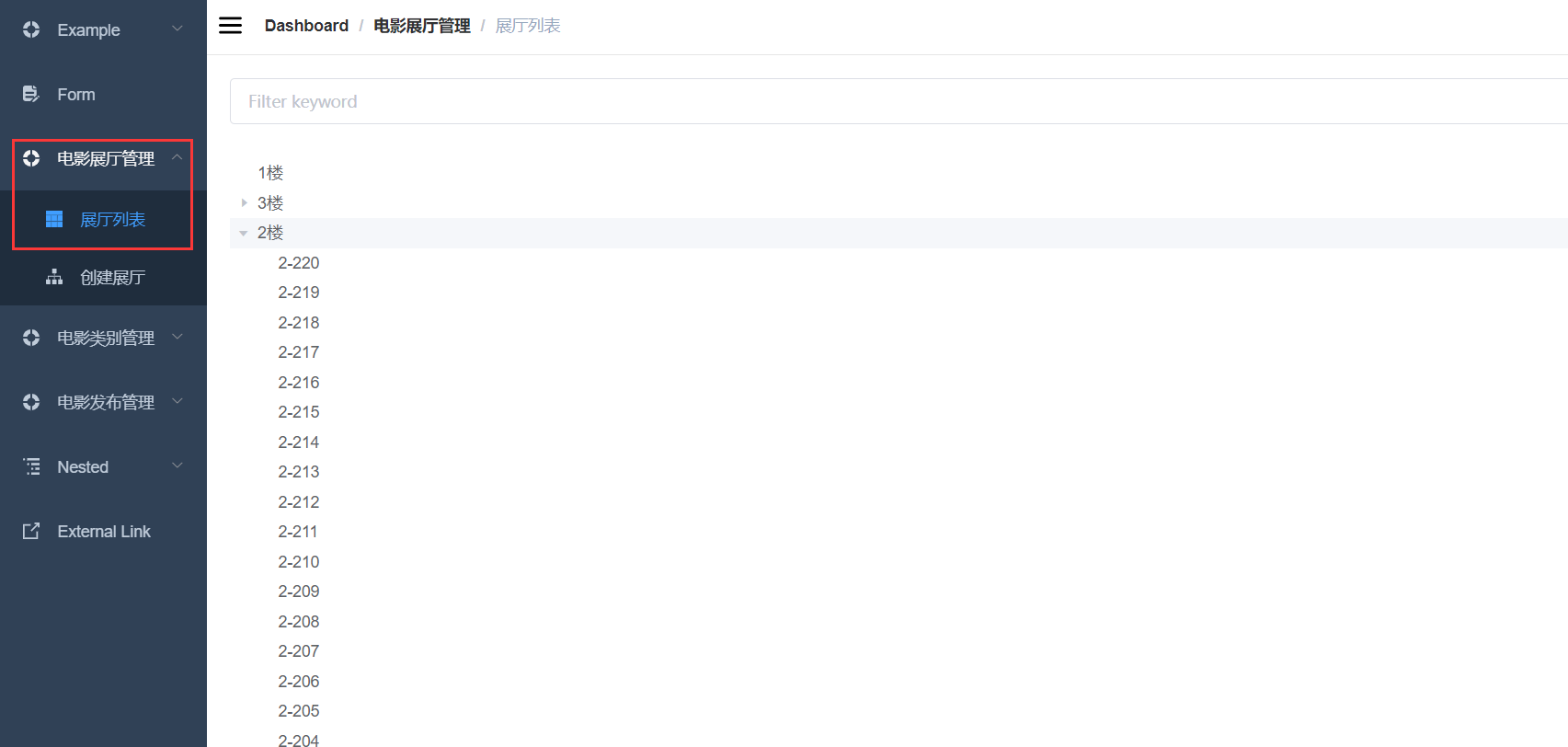
电影管理主要用于添加新电影的基本信息,以及使用FFMPEG技术对上传的视频进行进一步的操作,进而发布完整电影信息
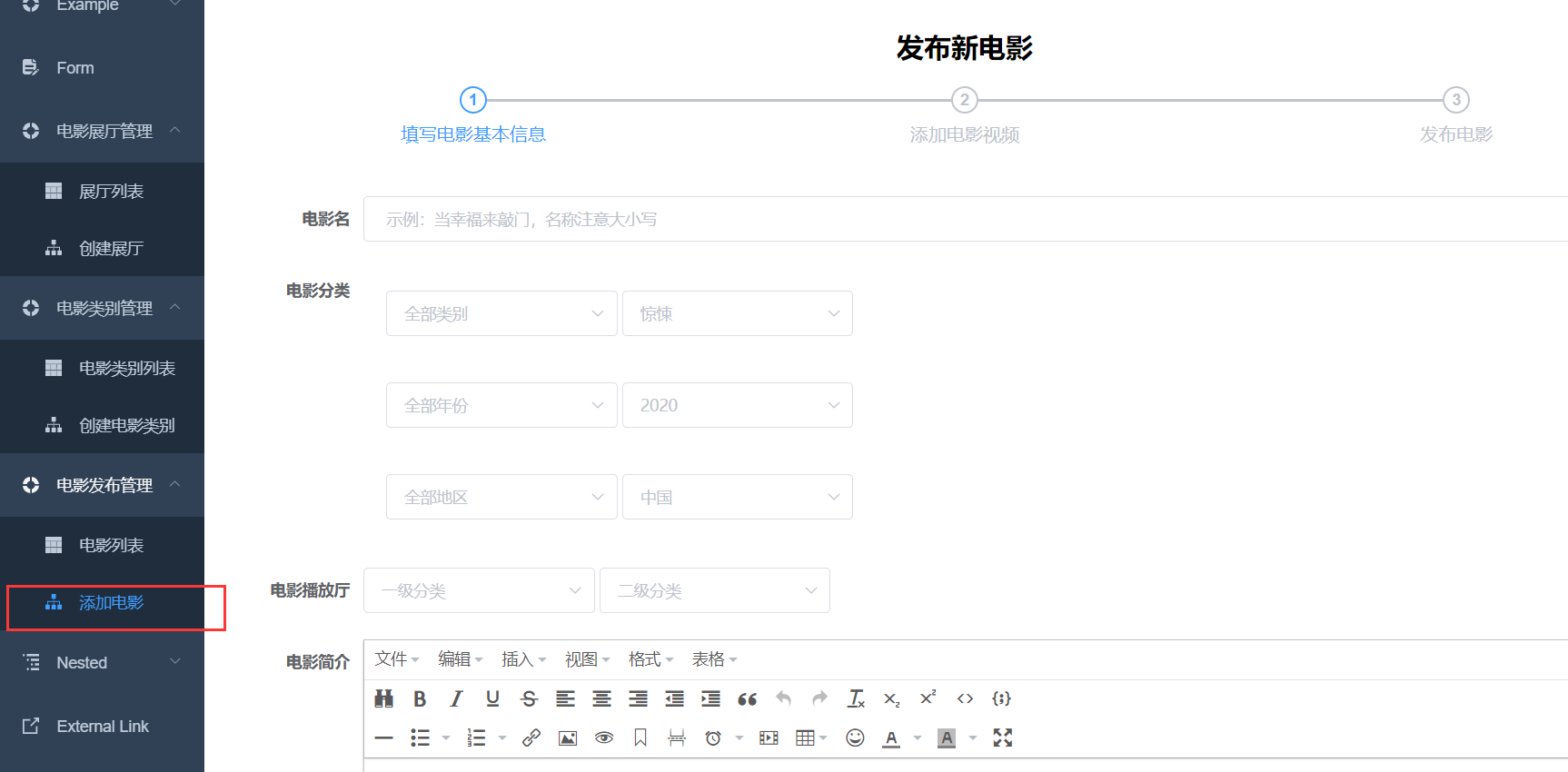
电影正式发布后的界面

使用命令 mvn archetype:generate -DgroupId=com.yiying -DartifactId=yiying-parent -DarchetypeArtifactId=maven-archetype-quickstart -DinteractiveMode=false
(1)对命令相关参数的说明:
(2)修改 pom 文件
导入 mybatis 相关依赖包,可以在https://mvnrepository.com网站中查询 mybatis 的包版本号
<dependencies>
<!-- Mybatis依赖包 3.5.3版本-->
<dependency>
<groupId>org.mybatis</groupId>
<artifactId>mybatis</artifactId>
<version>3.5.3</version>
</dependency>
<!-- Mysql版本依赖包-->
<dependency>
<groupId>mysql</groupId>
<artifactId>mysql-connector-java</artifactId>
<version>5.1.47</version>
<scope>runtime</scope>
</dependency>
<!-- Lombok版本依赖包-->
<dependency>
<groupId>org.projectlombok</groupId>
<artifactId>lombok</artifactId>
<version>1.18.12</version>
</dependency>
<!-- Junit测试依赖包-->
<dependency>
<groupId>junit</groupId>
<artifactId>junit</artifactId>
<version>4.12</version>
</dependency>
</dependencies>
再使用命令 mvn install 进行依赖打包
创建数据库以及创建表
--- 创建数据库
CREATE DATABASE test;
--- 使用数据库
USE test;
--- 创建相关表结构
CREATE TABLE `user` (
`id` char(19) NOT NULL COMMENT ‘会员id‘,
`name` varchar(50) DEFAULT NULL COMMENT ‘昵称‘,
`age` tinyint(3) unsigned DEFAULT NULL COMMENT ‘年龄‘,
PRIMARY KEY (`id`)
) ENGINE=InnoDB DEFAULT CHARSET=utf8mb4 COMMENT=‘会员表‘;
使用show tables 命令查看表是否创建成功
在resource文件下创建 mybatis-config.xml 配置文件
<?xml version="1.0" encoding="UTF-8" ?>
<!DOCTYPE configuration
PUBLIC "-//mybatis.org//DTD Config 3.0//EN"
"http://mybatis.org/dtd/mybatis-3-config.dtd">
<configuration>
<!-- 设置驼峰匹配 -->
<settings>
<!--开启二级缓存-->
<setting name="cacheEnabled" value="true"/>
</settings>
<!-- 设置包扫描(别名) -->
<typeAliases>
<package name="com.yiying.entity"/>
</typeAliases>
<!-- 配置环境:可以配置多个环境,default:配置某一个环境的唯一标识,表示默认使用哪个环境 -->
<environments default="development">
<environment id="development">
<transactionManager type="JDBC"/>
<dataSource type="POOLED"> <!--POOLED使用了连接池技术
type=”POOLED”: MyBatis 会创建 PooledDataSource 实例
type = "UNPOOLED" mybatis会创建UnpooledDataSource实例
type = "JNDI"mybatis会从JNDI服务上查找DataSource实例,然后返回使用
-->
<!-- 配置连接信息 -->
<property name="driver" value="com.mysql.jdbc.Driver"/>
<property name="url" value="jdbc:mysql://localhost:3306/test"/>
<property name="username" value="root"/>
<property name="password" value="xxx"/>
</dataSource>
</environment>
</environments>
<!-- 配置映射文件:用来配置sql语句和结果集类型等 -->
<mappers>
<!--映射器2
使用相对于类路径的资源
<mapper resource="mapper/UserMapper.xml"/>
使用mapper接口的类路径
<mapper class=""/>
扫描指定包下的mapper
<package name=""></package>
-->
<mapper resource="mapper/UserMapper.xml"/>
</mappers>
</configuration>
创建 Mapper 对数据库进行增删改查操作
//数据库中有多少字段对应类有多少属性,不然会报错
@Data //lombok的注解,用此注解可以不用对属性的getter和setter方法进行重写
public class User {
private String id;
private String name;
private String age;
}
@Mapper
public interface UserMapper {
//@Param 对传入的数据进行绑定,当参数为一个时,可以选择不加注解
//根据id查询用户信息
public User getInfo(@Param("id") String id);
//查询数据库所有的用户信息
List<User> findAll();
//增加一条用户信息
boolean insert(User user);
//根据用户id更新用户信息
boolean updateUser(User user);
//根据用户id删除用户信息
boolean removeById(String id);
//模糊查询
List<User> findByName(String username);
}
在 resource/mapper 文件下创建 xml 文件
<?xml version="1.0" encoding="UTF-8"?>
<!DOCTYPE mapper PUBLIC "-//mybatis.org//DTD Mapper 3.0//EN"
"http://mybatis.org/dtd/mybatis-3-mapper.dtd">
<!--命名空间需要与对应mapper类的路径一致-->
<mapper namespace="com.yiying.mapper.UserMapper">
<!--根据id查询用户信息-->
<select id="getInfo" resultType="com.yiying.entity.User" parameterType="java.lang.String">
SELECT id, name,age
FROM user
WHERE id = #{id}
</select>
<resultMap id="userMap" type="user">
<id column="id" property="id"/>
<result column="name" property="name"/>
<result column="age" property="age"/>
</resultMap>
<!--查询所有用户信息-->
<select id="findAll" resultMap="userMap" useCache="true">
select * from user
</select>
<!--模糊查询-->
<select id="findByName" resultType="com.yiying.entity.User">
select *
from user
where name like ‘%${name}%‘
</select>
<!--添加一条记录-->
<insert id="insert" parameterType="com.yiying.entity.User">
insert into user(id,name,age)
values(#{id},#{name},#{age})
</insert>
<!--根据用户id修改用户信息-->
<update id="updateUser" parameterType="com.yiying.entity.User">
update user set name=#{name},age=#{age} where id = #{id}
</update>
<!--根据用户id删除用户-->
<delete id="removeById" parameterType="java.lang.String">
delete
from user
where id = #{id}
</delete>
</mapper>
对增删改查操作进行测试
// 首先需要在 test 文件夹中创建测试类
//在处理测试时,先加载 init() 处理完测试后,加载 destory()
//在执行方法前执行
@Before
public void init() throws Exception {
//1.读取配置文件
in = Resources.getResourceAsStream("mybatis-config.xml");
//2.创建构建者对象
SqlSessionFactoryBuilder builder = new SqlSessionFactoryBuilder();
//3.创建 SqlSession 工厂对象
factory = builder.build(in);
//4.创建 Dao 接口的实现类
sqlSession = factory.openSession();
//5.创建代理对象
userMapper= sqlSession.getMapper(UserMapper.class);
}
/**
* 执行完方法后执行
*/
@After
public void destory(){
sqlSession.commit();
try {
sqlSession.close();
//释放资源
in.close();
} catch (IOException e) {
e.printStackTrace();
}
}
//查询
public class Test {
private InputStream in;
private SqlSessionFactory factory;
SqlSession sqlSession;
private UserMapper userMapper;
//根据id查询
@Test
public void test1(){
User user = userMapper.getInfo("1");
System.out.println(user);
}
@Test
public void test2(){
List<User> userList = userMapper.findAll();
System.out.println("查询的所有数据:" + userList.toString());
}
//模糊查询
@Test
public void test3(){
List<User> user = userMapper.findByName("张三");
System.out.println("根据名字模糊查询结果为:"+user.toString());
}
}


//新增一条记录
@Test
public void test4(){
User user = new User();
user.setId("2");
user.setName("张三四");
user.setAge(21);
boolean a = userMapper.insert(user);
if(a){
System.out.println("插入成功!!!!!!");
} else {
System.out.println("插入失败!!!!!!");
}
}

//根据 id 更新用户信息
@Test
public void test5(){
User user = new User();
user.setId("1");
user.setName("张三四五");
user.setAge(20);
boolean a = userMapper.updateUser(user);
if(a){
System.out.println("修改成功!!!!!!");
} else {
System.out.println("修改失败!!!!!!");
}
}

//根据id删除用户信息
@Test
@Test
public void test6(){
boolean a = userMapper.removeById("2");
if(a){
System.out.println("插入成功!!!!!!");
} else {
System.out.println("插入失败!!!!!!");
}
}

在应用运行过程中,我们有可能在一次数据库会话中,执行多次查询条件完全相同的 SQL,MyBatis 提供了一级缓存的方案优化这部分场景,如果是相同的 SQL 语句,会优先命中一级缓存,避免直接对数据库进行查询,提高性能。具体执行过程如下图所示。
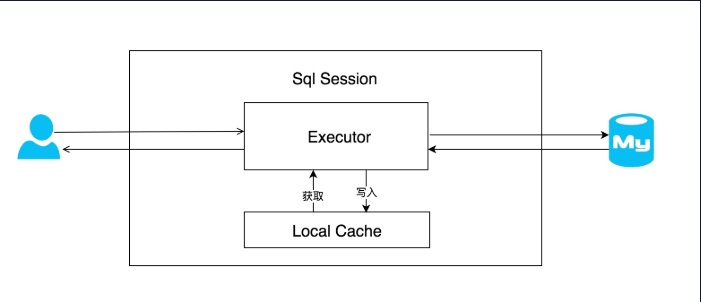
每个 SqlSession 中持有了 Executor,每个 Executor 中有一个 LocalCache。当用户发起查询时,MyBatis 根据当前执行的语句生成 MappedStatement,在 Local Cache 进行查询,如果缓存命中的话,直接返回结果给用户,如果缓存没有命中的话,查询数据库,结果写入 Local Cache,最后返回结果给用户。具体实现类的类关系图如下图所示。
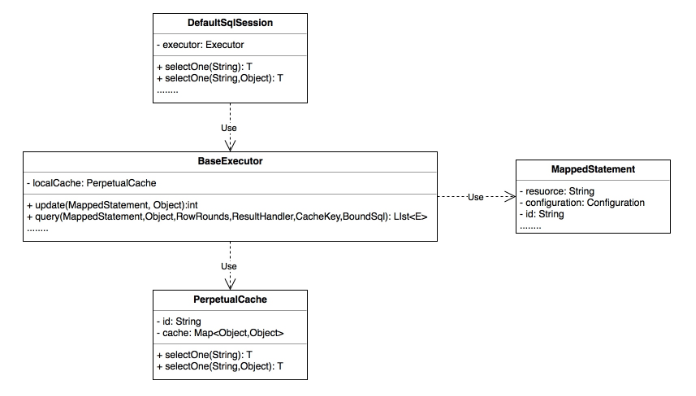
我们来看看如何使用 MyBatis 一级缓存。开发者只需在MyBatis的配置文件中,添加如下语句,就可以使用一级缓存。共有两个选项,SESSION或者 STATEMENT,默认是 SESSION 级别,即在一个 MyBatis 会话中执行的所有语句,都会共享这一个缓存。一种是 STATEMENT 级别,可以理解为缓存只对当前执行的这一个 Statement 有效。
<setting name="localCacheScope" value="SESSION"/>
接下来通过实验,了解 MyBatis 一级缓存的效果,每个单元测试后都请恢复被修改的数据。
首先是创建示例表 student,创建对应的 POJO 类和增改的方法,具体可以在 entity 包和 mapper 包中查看。
CREATE TABLE `student` (
`id` int(11) unsigned NOT NULL AUTO_INCREMENT,
`name` varchar(200) COLLATE utf8_bin DEFAULT NULL,
`age` tinyint(3) unsigned DEFAULT NULL,
PRIMARY KEY (`id`)
) ENGINE=InnoDB AUTO_INCREMENT=4 DEFAULT CHARSET=utf8 COLLATE=utf8_bin;
在以下实验中,id为1的学生名称是凯伦。
开启一级缓存,范围为会话级别,调用三次 getStudentById,代码如下所示:
public void getStudentById() throws Exception {
SqlSession sqlSession = factory.openSession(true); // 自动提交事务
StudentMapper studentMapper = sqlSession.getMapper(StudentMapper.class);
System.out.println(studentMapper.getStudentById(1));
System.out.println(studentMapper.getStudentById(1));
System.out.println(studentMapper.getStudentById(1));
}
执行结果:

我们可以看到,只有第一次真正查询了数据库,后续的查询使用了一级缓存。
增加了对数据库的修改操作,验证在一次数据库会话中,如果对数据库发生了修改操作,一级缓存是否会失效。
@Test
public void addStudent() throws Exception {
SqlSession sqlSession = factory.openSession(true); // 自动提交事务
StudentMapper studentMapper = sqlSession.getMapper(StudentMapper.class);
System.out.println(studentMapper.getStudentById(1));
System.out.println("增加了" + studentMapper.addStudent(buildStudent()) + "个学生");
System.out.println(studentMapper.getStudentById(1));
sqlSession.close();
}
执行结果:

我们可以看到,在修改操作后执行的相同查询,查询了数据库,一级缓存失效。
开启两个 SqlSession,在 sqlSession1 中查询数据,使一级缓存生效,在sqlSession2 中更新数据库,验证一级缓存只在数据库会话内部共享。
@Test
public void testLocalCacheScope() throws Exception {
SqlSession sqlSession1 = factory.openSession(true);
SqlSession sqlSession2 = factory.openSession(true);
StudentMapper studentMapper = sqlSession1.getMapper(StudentMapper.class);
StudentMapper studentMapper2 = sqlSession2.getMapper(StudentMapper.class);
System.out.println("studentMapper读取数据: " + studentMapper.getStudentById(1));
System.out.println("studentMapper读取数据: " + studentMapper.getStudentById(1));
System.out.println("studentMapper2更新了" + studentMapper2.updateStudentName("小岑",1) + "个学生的数据");
System.out.println("studentMapper读取数据: " + studentMapper.getStudentById(1));
System.out.println("studentMapper2读取数据: " + studentMapper2.getStudentById(1));
}

sqlSession2 更新了id为1的学生的姓名,从凯伦改为了小岑,但 session1 之后的查询中,id为1的学生的名字还是凯伦,出现了脏数据,也证明了之前的设想,一级缓存只在数据库会话内部共享。
在上文中提到的一级缓存中,其最大的共享范围就是一个 SqlSession 内部,如果多个 SqlSession之间需要共享缓存,则需要使用到二级缓存。开启二级缓存后,会使用 CachingExecutor 装饰Executor,进入一级缓存的查询流程前,先在 CachingExecutor 进行二级缓存的查询,具体的工作流程如下所示。
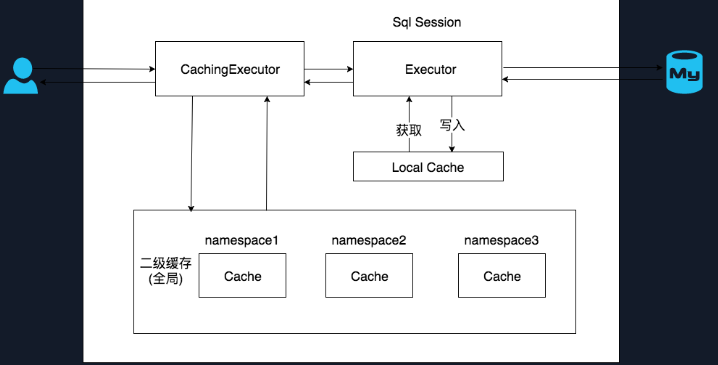
二级缓存开启后,同一个 namespace 下的所有操作语句,都影响着同一个 Cache,即二级缓存被多个 SqlSession 共享,是一个全局的变量。
当开启缓存后,数据的查询执行的流程就是 二级缓存 -> 一级缓存 -> 数据库。
要正确的使用二级缓存,需完成如下配置的。
<setting name="cacheEnabled" value="true"/>
cache标签用于声明这个 namespace 使用二级缓存,并且可以自定义配置。
<cache/>
type:cache使用的类型,默认是 PerpetualCache,这在一级缓存中提到过。eviction: 定义回收的策略,常见的有 FIFO,LRU。flushInterval: 配置一定时间自动刷新缓存,单位是毫秒。size: 最多缓存对象的个数。readOnly: 是否只读,若配置可读写,则需要对应的实体类能够序列化。blocking: 若缓存中找不到对应的key,是否会一直blocking,直到有对应的数据进入缓存。cache-ref 代表引用别的命名空间的Cache配置,两个命名空间的操作使用的是同一个 Cache。<cache-ref namespace="mapper.StudentMapper"/>
接下来我们通过实验,了解 MyBatis 二级缓存在使用上的一些特点。
在本实验中,id 为1的学生名称初始化为点点。
测试二级缓存效果,不提交事务,sqlSession1 查询完数据后,sqlSession2 相同的查询是否会从缓存中获取数据。
@Test
public void testCacheWithoutCommitOrClose() throws Exception {
SqlSession sqlSession1 = factory.openSession(true);
SqlSession sqlSession2 = factory.openSession(true);
StudentMapper studentMapper = sqlSession1.getMapper(StudentMapper.class);
StudentMapper studentMapper2 = sqlSession2.getMapper(StudentMapper.class);
System.out.println("studentMapper读取数据: " + studentMapper.getStudentById(1));
System.out.println("studentMapper2读取数据: " + studentMapper2.getStudentById(1));
}
执行结果:

我们可以看到,当 sqlsession 没有调用 commit() 方法时,二级缓存并没有起到作用。
测试二级缓存效果,当提交事务时,sqlSession1 查询完数据后,sqlSession2 相同的查询是否会从缓存中获取数据。
@Test
public void testCacheWithCommitOrClose() throws Exception {
SqlSession sqlSession1 = factory.openSession(true);
SqlSession sqlSession2 = factory.openSession(true);
StudentMapper studentMapper = sqlSession1.getMapper(StudentMapper.class);
StudentMapper studentMapper2 = sqlSession2.getMapper(StudentMapper.class);
System.out.println("studentMapper读取数据: " + studentMapper.getStudentById(1));
sqlSession1.commit();
System.out.println("studentMapper2读取数据: " + studentMapper2.getStudentById(1));
}

从图上可知,sqlsession2 的查询,使用了缓存,缓存的命中率是0.5。
测试 update 操作是否会刷新该 namespace 下的二级缓存。
@Test
public void testCacheWithUpdate() throws Exception {
SqlSession sqlSession1 = factory.openSession(true);
SqlSession sqlSession2 = factory.openSession(true);
SqlSession sqlSession3 = factory.openSession(true);
StudentMapper studentMapper = sqlSession1.getMapper(StudentMapper.class);
StudentMapper studentMapper2 = sqlSession2.getMapper(StudentMapper.class);
StudentMapper studentMapper3 = sqlSession3.getMapper(StudentMapper.class);
System.out.println("studentMapper读取数据: " + studentMapper.getStudentById(1));
sqlSession1.commit();
System.out.println("studentMapper2读取数据: " + studentMapper2.getStudentById(1));
studentMapper3.updateStudentName("方方",1);
sqlSession3.commit();
System.out.println("studentMapper2读取数据: " + studentMapper2.getStudentById(1));
}

我们可以看到,在 sqlSession3 更新数据库,并提交事务后,sqlsession2 的StudentMapper namespace 下的查询走了数据库,没有走Cache。
验证MyBatis的二级缓存不适应用于映射文件中存在多表查询的情况。
通常我们会为每个单表创建单独的映射文件,由于MyBatis的二级缓存是基于 namespace 的,多表查询语句所在的 namspace 无法感应到其他 namespace 中的语句对多表查询中涉及的表进行的修改,引发脏数据问题。
@Test
public void testCacheWithDiffererntNamespace() throws Exception {
SqlSession sqlSession1 = factory.openSession(true);
SqlSession sqlSession2 = factory.openSession(true);
SqlSession sqlSession3 = factory.openSession(true);
StudentMapper studentMapper = sqlSession1.getMapper(StudentMapper.class);
StudentMapper studentMapper2 = sqlSession2.getMapper(StudentMapper.class);
ClassMapper classMapper = sqlSession3.getMapper(ClassMapper.class);
System.out.println("studentMapper读取数据: " + studentMapper.getStudentByIdWithClassInfo(1));
sqlSession1.close();
System.out.println("studentMapper2读取数据: " + studentMapper2.getStudentByIdWithClassInfo(1));
classMapper.updateClassName("特色一班",1);
sqlSession3.commit();
System.out.println("studentMapper2读取数据: " + studentMapper2.getStudentByIdWithClassInfo(1));
}
执行结果:

在这个实验中,我们引入了两张新的表,一张 class,一张 classroom。class 中保存了班级的 id 和班级名,classroom中保存了班级 id 和学生 id。我们在 StudentMapper 中增加了一个查询方法 getStudentByIdWithClassInfo,用于查询学生所在的班级,涉及到多表查询。在 ClassMapper 中添加了 updateClassName,根据班级 id 更新班级名的操作。
当 sqlsession1 的 studentmapper 查询数据后,二级缓存生效。保存在 StudentMapper的 namespace 下的 cache 中。当 sqlSession3 的 classMapper`的 updateClassName 方法对class表进行更新时,updateClassName 不属于StudentMapper 的 namespace,所以 StudentMapper 下的cache没有感应到变化,没有刷新缓存。当 StudentMapper 中同样的查询再次发起时,从缓存中读取了脏数据。
为了解决实验4的问题呢,可以使用 Cache ref,让 ClassMapper 引用 StudenMapper 命名空间,这样两个映射文件对应的 SQL 操作都使用的是同一块缓存了。
执行结果:

不过这样做的后果是,缓存的粒度变粗了,多个 Mapper namespace 下的所有操作都会对缓存使用造成影响。
原文:https://www.cnblogs.com/windyCoding/p/14188414.html